Related Research Articles

Vivianite (Fe(II)
3(PO
4)
2·8H
2O) is a hydrated iron(II) phosphate mineral found in a number of geological environments. Small amounts of manganese Mn2+, magnesium Mg2+, and calcium Ca2+ may substitute for iron Fe2+ in its structure. Pure vivianite is colorless, but the mineral oxidizes very easily, changing the color, and it is usually found as deep blue to deep bluish green prismatic to flattened crystals. Vivianite crystals are often found inside fossil shells, such as those of bivalves and gastropods, or attached to fossil bone. Vivianite can also appear on the iron coffins or on the corpses of humans as a result of a chemical reaction of the decomposing body with the iron enclosure.
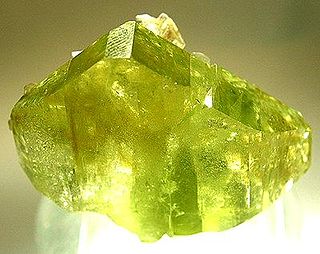
Brazilianite, whose name derives from its country of origin, Brazil, is a typically yellow-green phosphate mineral, most commonly found in phosphate-rich pegmatites.
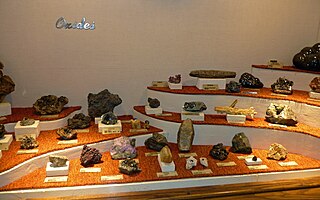
The oxide mineral class includes those minerals in which the oxide anion (O2−) is bonded to one or more metal alloys. The hydroxide-bearing minerals are typically included in the oxide class. Minerals with complex anion groups such as the silicates, sulfates, carbonates and phosphates are classed separately.

Vauxite is a phosphate mineral with the chemical formula Fe2+Al2(PO4)2(OH)2·6(H2O). It belongs to the laueite – paravauxite group, paravauxite subgroup, although Mindat puts it as a member of the vantasselite Al4(PO4)3(OH)3·9H2O group. There is no similarity in structure between vauxite and paravauxite Fe2+Al2(PO4)2(OH)2·8H2O or metavauxite Fe3+Al2(PO4)2(OH)2·8H2O, even though they are closely similar chemically and all minerals occur together as secondary minerals. Vauxite was named in 1922 for George Vaux Junior (1863–1927), an American attorney and mineral collector.

Beraunite is an iron phosphate mineral. It was first described by August Breithaupt for an occurrence in Beraun currently in the Czech Republic. Beraunite occurs as a secondary mineral in iron ore deposits, and as an alteration product of primary phosphate minerals in granite pegmatites.
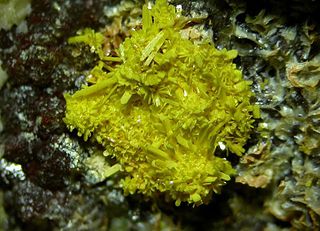
Bergenite is a rare uranyl phosphate of the more specific phosphuranylite group. The phosphuranylite-type sheet in bergenite is a new isomer of the group, with the uranyl phosphate tetrahedra varying in an up-up-down, same-same-opposite (uuduudSSOSSO) orientation. All bergenite samples have been found in old mine dump sites. Uranyl minerals are a large constituent of uranium deposits.

Hureaulite is a manganese phosphate with the formula Mn2+5(PO3OH)2(PO4)2·4H2O. It was discovered in 1825 and named in 1826 for the type locality, Les Hureaux, Saint-Sylvestre, Haute-Vienne, Limousin, France. It is sometimes written as huréaulite, but the IMA does not recommend this for English language text.

Plumbogummite is a rare secondary lead phosphate mineral, belonging to the alunite supergroup of minerals, crandallite subgroup. Some other members of this subgroup are:

Tsumebite is a rare phosphate mineral named in 1912 after the locality where it was first found, the Tsumeb mine in Namibia, well known to mineral collectors for the wide range of minerals found there. Tsumebite is a compound phosphate and sulfate of lead and copper, with hydroxyl, formula Pb2Cu(PO4)(SO4)(OH). There is a similar mineral called arsentsumebite, where the phosphate group PO4 is replaced by the arsenate group AsO4, giving the formula Pb2Cu(AsO4)(SO4)(OH). Both minerals are members of the brackebuschite group.
This list gives an overview of the classification of non-silicate minerals and includes mostly International Mineralogical Association (IMA) recognized minerals and its groupings. This list complements the List of minerals recognized by the International Mineralogical Association series of articles and List of minerals. Rocks, ores, mineral mixtures, not IMA approved minerals, not named minerals are mostly excluded. Mostly major groups only, or groupings used by New Dana Classification and Mindat.
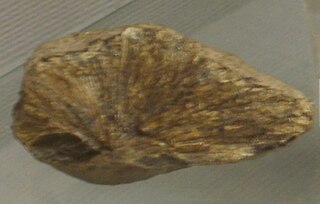
Satterlyite is a hydroxyl bearing iron phosphate mineral. The mineral can be found in phosphatic shales and was first discovered in the Big Fish River area in Yukon Territory, Canada.
Penikisite was discovered by Alan Kulan and Gunar Penikis near Rapid Creek, Yukon Territory. The mineral is a member of the bjarebyite group along with kulanite, ideally BaFe2+2Al2(PO4)3(OH)3, and bjarebyite, ideally BaMn2+2Al2(PO4)3(OH)3. It is among several new minerals that have been discovered in the Rapid Creek and Big Fish areas of Yukon Territory. Kulanite is similar in many ways to penikisite in appearance and properties. The chemical formula for penikisite is Ba(Mg,Fe,Ca)Al2(PO4)2(OH)3. It has a hardness of about 4 and a density of 3.79 g/cm3. Penikisite is unique among the bjarebyite group in being monoclinic and has a biaxial optical class. It comes in shades of blue and green and, when rubbed on a streak plate, is pale green to white in color. Although penikisite and kulanite both range from blue to green, penikisite zones are easily distinguishable from kulanite zones in kulanite-penikisite crystals because they are lighter than the darker kulanite in color. Penikisite is a phosphate and is different from kulanite in that it is a magnesium-rich phosphate whereas kulanite is an iron-rich phosphate.

Collinsite is a mineral with chemical formula Ca
2(Mg,Fe2+
)(PO
4)
2•2H
2O. It was discovered in British Columbia, Canada, and formally described in 1927. It was named in honor of William Henry Collins (1878–1937), director of the Geological Survey of Canada. There are three varieties of the mineral: magnesian collinsite, zincian collinsite, and strontian collinsite. The crystal structure consists of polyhedral chains linked by weak hydrogen bonds.
Ferraioloite is a rare mineral with formula MgMn2+4(Fe2+0.5Al0.5)4Zn4(PO4)8(OH)4(H2O)20. It is related to the phosphate mineral falsterite. Ferraioloite was found in pegmatites of the Foote Lithium Company Mine, Cleveland County, North Carolina, US. The name honors James (Jim) A. Ferraiolo (1947–2014).
Bartelkeite is an exceptionally rare mineral, one of scarce natural germanium compounds. The formula was originally assumed to be PbFeGe3O8, bartelkeite was later shown to be isostructural with a high-pressure form of the mineral lawsonite. Thus, its correct formula is PbFeGe(Ge2O7)(OH)2•H2O. Bartelkeite and mathewrogersite are minerals with essential (dominant) lead, iron and germanium. Both come from Tsumeb, Namibia - a world's "capital" of germanium minerals.
Manganese phosphate may refer to:
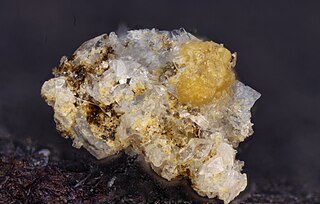
Zigrasite is a phosphate mineral with the chemical formula of MgZr(PO4)2(H2O)4. Zigrasite was discovered and is only known to occur in the Dunton Quarry at Oxford County, Maine. Zigrasite was specifically found in the giant 1972 gem tourmaline-bearing pocket at the Dunton Quarry. Zigrasite is named after James Zigras who originally discovered and brought the mineral to attention.

Serrabrancaite is a mineral with the chemical formula MnPO4•H2O and which is named for the locality where it was found, the Alto Serra Branca Pegmatite. The Alto Serra Branca mine has been in operation since the 1940s. It is located in Paraiba, Brazil near a village named Pedra Lavrada. Tantalite is the main mineral mined here. Specimens of serrabrancaite are kept in the Mineralogical Collections of both the Bergakademie Freiberg, Germany and the Martin-Luther Universität Halle, Institut für Geologische Wissenschaften.
Cattiite is a phosphate mineral. The mineral was first found in a veins of dolomite carbonatites veins at the bottom of the Zhelezny (Iron) Mine in the Kovdor massif, Kola Peninsula, Russia. Cattiite was tentatively identified as Mg3(PO4)2·22H2O, which as a high hydrate magnesium orthophosphate. Later structural studies, revealed the existence of two polytypes named Mg3(PO4)2·22H2O-1A1 and Mg3(PO4)2·22H2O-1A2.
Rockbridgeite is an anhydrous phosphate mineral in the "Rockbridgeite" supergroup with the chemical formula Fe2+Fe3+4(PO4)3(OH)5. It was discovered at the since-shut-down Midvale Mine in Rockbridge County, Virginia, United States. The researcher who first identified it, Clifford Frondel, named it in 1949 for its region of discovery, Rockbridge County.
References
- ↑ Warr, L.N. (2021). "IMA–CNMNC approved mineral symbols". Mineralogical Magazine. 85 (3): 291–320. Bibcode:2021MinM...85..291W. doi: 10.1180/mgm.2021.43 . S2CID 235729616.
- 1 2 3 4 Kampf, A.R., Mills, S.J., Simmons, W.B., Nizamoff, J.W., and Whitmore, R.W., 2012. Falsterite, Ca2MgMn2+2(Fe2+0.5Fe3+0.5)4Zn4(PO4)8(OH)4(H2O)14, a new secondary phosphate mineral from the Palermo No. 1 pegmatite, North Groton, New Hampshire. American Mineralogist 97(4), 496-502
- 1 2 3 "Falsterite: Falsterite mineral information and data". Mindat.org. Retrieved 2016-03-04.